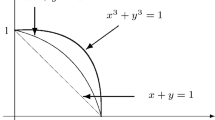Abstract
Strengths, weaknesses, opportunities and threats (SWOT) matrix is one of the most used tools for strategic planning, specially in the stage of extracting strategies. While the use of SWOT analysis is quite common and popular, it still continuous to have certain structural problems such that: the lack of considering uncertain and boolean (two sided) factors, lack of prioritization of the factors and too many extractable strategies. In this paper, we deal with the analytic hierarchy process (AHP) to find weights of SWOT groups and weights of sub-factors within each groups; and we make use of the technique for order preference by similarity to ideal solution (TOPSIS) methodology to determine strategies priority. In addition, in order to deal with uncertainty and vagueness, we incorporate axiomatic fuzzy set (AFS) theory instead of traditional fuzzy set theory. AHP and TOPSIS are applied to the light of AFS theory. The advantages of dealing with AFS theory in the proposed approach are that: it can directly be applied to the data, the features of the data-sets can be mixed; however, the traditional fuzzy set theory deals with fuzzy numbers and it’s clear that different fuzzy numbers will lead to different results; hence the inconsistency of previous methodologies, described in the literature, copes with the methodology proposed in this paper.
Similar content being viewed by others
References
Chou, C.H., Liang, G.S., Chang, H.C.: A fuzzy approach based on the concept of possibility extent. Qual. Quant. (2011). doi:10.1007/s11135-011-9473-6
Diamantopoulou P., Voudouris K.: Optimization of water resources management using SWOT analysis: the case of Zakynthos Island, Ionian Sea, Greece. Environ. Geol. 54, 197–211 (2008)
Ghorbani, M., Velayati, R., Ghorbani, M.M.: Using Fuzzy TOPSIS to determine strategy priorities by SWOT analysis 2011 : Int. Conf. Financ. Manag. Econ. 11, 135–139 (2011)
Graver J.E., Watkins M.E.: Combinatorics with emphasis on the theory of graphs. Springer-Verlag, New York (1997)
Hwang C.L., Yoon K.: Multiple attribute decision making-methods and applications. Springer-Verlag, Heidelberg (1981)
Jahanshaloo G.H., Lotfi F.H., Izadikhah M.: Extension of the TOPSIS method for decision making problems with fuzzy data. Appl. Math. Comput. 181, 1544–1551 (2006)
Kurttila M., Pesonen M., Kangas J., Kajanus M.: Utilising the analytic hierarchy (AHP) in SWOT analysis- a hybrid method and its application to a forest- certification case. For. Policy. Econ. 1, 41–52 (2000)
Lee K.L., Huang W.C., Teng J.Y.: Locating the competitive relation of global logistics hub using quantitative SWOT analytical method. Qual. Quant. 43, 87–107 (2009)
Li Y., Liu X.D., Chen Y.: Selection of logistics center location using axiomatic fuzzy set and topsis methodology in logistics management. Expert. Syst. Appl. 38, 7901–7908 (2011)
Liang G.S., Chou T.Y., Han T.C.: Cluster analysis based on fuzzy equivalence relation. Eur. J. Oper. Res. 166, 160–171 (2005)
Liu X.D.: The Fuzzy theory based on AFS algebras and AFS structure. J. Math. Anal. Appl. 217, 459–478 (1998)
Liu X.D., Pedrycz W.: The development of fuzzy decision trees in the framework of axiomatic fuzzy set logic. Appl. Soft comput. 7, 325–342 (2007)
Liu X.D., Pedrycz W., Zhang Q.L.: Axiomatics fuzzy sets logic. Proc. IEEE Int. Conf. Fuzzy Syst. 1, 55–60 (2003)
Liu X.D., Wang W., Chai T.Y.: The fuzzy clustering analysis based on AFS theory. IEEE Trans. Syst. Man Cybern. Part B. 35, 1013–1027 (2005)
Liu X.D., Chai T.Y., Wang W.: AFS fuzzy logic systems and its applications to model and control. Int. J. Inf. Syst. Sci. 2, 285–305 (2006)
Liu X.D., Chai T.Y., Wang W.: Approaches to the representations and logic operations for fuzzy concepts in the framework of axiomatic fuzzy set theory I. Inf. Sci. 177, 1007–1026 (2007a)
Liu X.D., Chai T.Y., Wang W.: Approaches to the representations and logic operations for fuzzy concepts in the framework of axiomatic fuzzy set theory II. Inf. Sci. 177, 1027–1045 (2007b)
Miller C.C., Cardinal L.B.: Strategic Planning and firm performance: asynthesis of more than two decades of research. Acad. Manag. J. 37, 1649–1665 (1994)
Porter M.E.: Competitive strategy: techniques for analysing industries and competitors. Free Press, New York (1980)
Porter M.E.: Competitive advantages: creating and sustaining superior performance. Free Press, New York (1985)
Saaty T.L.: A scaling method for priorities in hierarchical structures. J. Math. Psychol. 15, 234–281 (1977)
Saaty T.L.: The analytic hierarchy process. Mc Graw-Hill, New York (1980)
Saaty T.L.: The analytic hierarchy process: a 1993 overview. Cent. Eur. J. Oper. Res. Econ. 2, 119–137 (1993)
Saaty T.L., Vergas L.G.: Models, methods, concepts and applications of the analytic hierarchy process. Kluwer Academic Publishers, Boston (2001)
Shih H.S., Shyur H.J., Stanley L.: An extension of TOPSIS for group decision making. Math. Comput. Model. 45, 801–813 (2007)
Tahernejad, M.M., Khalokakaie, R., Ataei, M.: Determining proper strategies for Iran’s dimensional stone mines: SWOT-AHP analysis. Arab. J. Geosci. (2011). doi:10.1007/s12517-011-0331-6
Tao, L.L., Chen, Y., Liu, X.D.: An integrated multiple criteria decision making model applying axiomatic fuzzy set theory. Appl. Math. Model. (2011) (in press)
Vaidvay O.S., Kumar S.: Analytic hierarchy process: an overview of applications. Eur. J. Oper. Res. 169, 1–29 (2006)
Wang G.J.: Theory of topological molecular lattices. Fuzzy Sets. Syst. 47, 351–376 (1992)
Wu H.H., Tsai Y.N.: Using AHP to evaluate the criteria of auto spare parts industry. Qual.Quant. 46, 359–364 (2012)
Yuksel I., Dagdevirien M.: Using the analytic network process (ANP) in a SWOT analysis-A case study for a textile firm. Inf. Sci. 117, 3364–3382 (2007)
Author information
Authors and Affiliations
Corresponding author
Rights and permissions
About this article
Cite this article
Menga Ebonzo, A.D., Liu, X. The use of axiomatic fuzzy set theory in AHP and TOPSIS methodology to determine strategies priorities by SWOT analysis. Qual Quant 47, 2671–2685 (2013). https://doi.org/10.1007/s11135-012-9679-2
Published:
Issue Date:
DOI: https://doi.org/10.1007/s11135-012-9679-2




